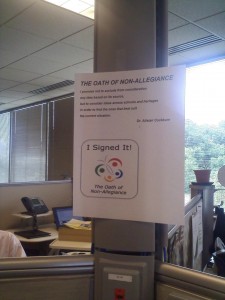Marketers sometimes encounter Agile developers so full of themselves they’re leaking hubris all over the Kanban board. There is no part of the Agile Manifesto that says “It’s nothing personal – it’s just that we’re better than you”. But since most marketers are not that familiar with Agile principles, it’s not surprising that they blame the practice and not the practitioner when they encounter this behavior.
Does Agile breed arrogance? No more than ships cause barnacles. Agile in its best form fosters empowerment, and empowerment is very different from arrogance. It’s empowerment to use the best idea, not “I reject your reality and substitute my own.” In my opinion, arrogance is a perversion of Agile methodology, and an enemy of Agile acceptance and integration. The real evangelists of Agile are the ones who can communicate to the business what’s good about Agile in terms other than what’s good for developers.
But other Agile evangelists, in their zeal to bring the good news to those perceived to be waterfall worshippers, will assign Agile cult status. They then think they have license to shun and ridicule those who are not in the cult.
When a member of an Agile development team treats a marketer like a superfluous throwback, talks to him condescendingly, uses lean requirements as an excuse to build to their own vision instead of collaborating, and rolls their eyes and smirks when disagreements arise, the marketer blames this abuse on Agile. A product manager who works diligently with a team, sees her input ignored, then ends up with a product that technically works but users hate, concludes that Agile doesn’t work for product development. A brand manager who discovers shortly before launch that the development team was only pretending to work with him to prevent any interference in their workflow (via a process known as blocking), sees Agile as the justification for bad behavior. Things you might hear:
“I’m not changing my design just because UX said it’s not customer-friendly. That’s just their opinion.”
I don’t buy the premise that collaboration means that all opinions are created equal. I’m a database guy who is reasonably well-informed on user-centered interactive design and architecture. But branding myself a UX expert because I once listened to a Jared Spool podcast is as intellectually honest as saying I’m a nuclear expert because I stayed at a Holiday Inn Express. There are professionals that do UX for a living, and there’s a boatload of best practices that they know about and I don’t. Inclusion is great, and we’re all special, but neither my opinion nor the developer’s should carry more weight than the expert in the room. Nobody’s an expert on everything.
“We can’t take sprint time away from features coding to work on analytics – you don’t really need the data anyway.”
What the what? Do you build a car without a speedometer so you can get the leather seats just right? Do you refuse to take your temperature when you’re sick, because your intuition is better at detecting a fever? The business flies blind without success metrics, and the developer shouldn’t have line-item veto power over them. Of course, the analytics people shouldn’t be the only ones insisting on tracking. The business should be the ones to push back on any pressure to jettison analytics in order to cram more features into the sprint.
“You’ll have to prove to me that this enhancement is worth my time.”
Everyone who touches a project should know its purpose, its goals, its worth to the business, etc. If the business is not using proper discipline to prioritize projects, the development team may be within its rights to question whether an item belongs on a sprint. That doesn’t mean developers have unilateral authority to pick what they’re going to work on.
Agile can energize marketers and allow them to respond more nimbly and decisively to the needs of the business. But marketers must trust the process and trust the players to make Agile collaboration a success. If the trust is not there, or has been broken, it’s not a small “grumble at the watercooler” type of problem. It’s an emergency that must be resolved before real progress can be made.

